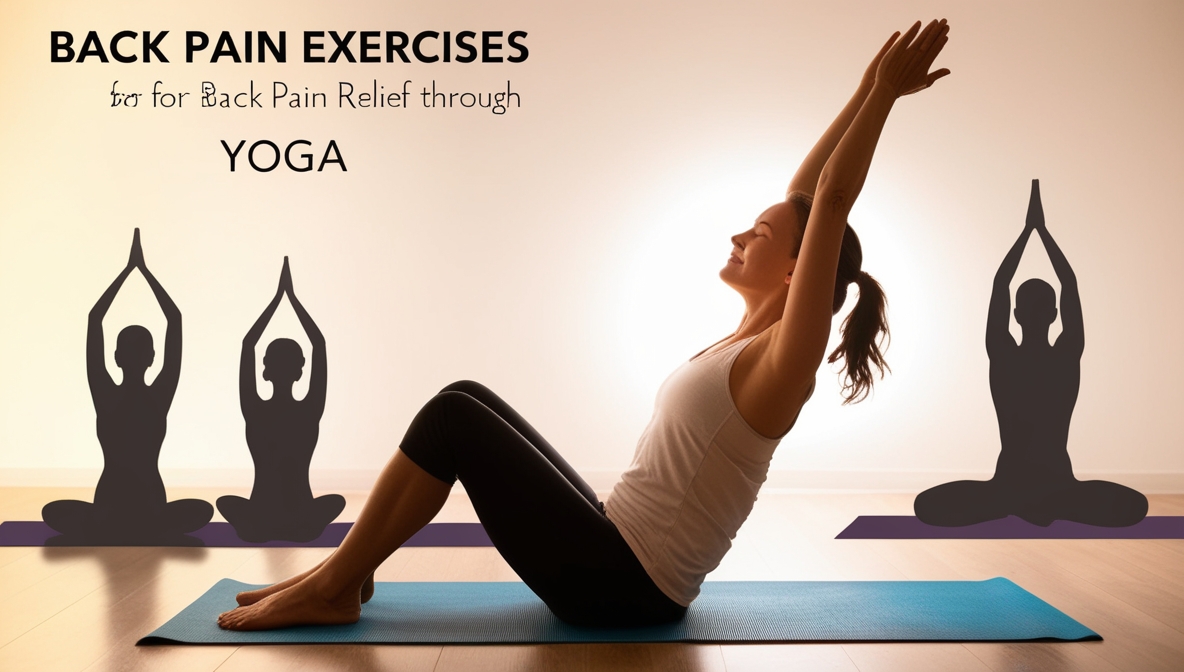Back pain affects millions globally, significantly impacting daily life and well-being. Yet, yoga offers a natural, holistic approach to relief and core strength. This piece delves into how targeted yoga practices can ease back pain, foster healing, and boost overall health.

Key Takeaways
- Yoga can effectively alleviate back pain and strengthen the core muscles.
- Understanding the common causes of back pain is crucial for tailoring an effective yoga practice.
- Gentle, restorative, and strengthening yoga poses can provide relief and improve overall spine health.
- Incorporating mindfulness and breathing techniques enhances the benefits of a yoga practice for back pain management.
- Lifestyle changes, such as proper posture and weight management, can prevent and manage back pain in the long run.
Understanding Back Pain and Its Causes
Back pain is a widespread issue that can severely affect daily life. To effectively manage chronic pain management, it’s essential to grasp the causes of back discomfort. Various factors, from poor posture to underlying medical conditions, contribute to back pain.
Common Causes of Back Pain
- Muscle strain or sprain due to overuse, injury, or poor lifting techniques
- Herniated or bulging discs in the spine, which can put pressure on the nerves
- Degenerative disc disease, a natural consequence of aging that can lead to disc problems
- Osteoarthritis, a form of arthritis that can affect the spine and cause pain
- Yoga for injuries can be an effective way to address some of these common causes of back pain
The Impact of Back Pain on Daily Life
Back pain significantly affects an individual’s quality of life, making everyday tasks challenging. Those experiencing back pain may face:
- Reduced mobility and difficulty with activities such as walking, sitting, or standing for extended periods
- Decreased physical activity and exercise, leading to a decline in overall fitness and well-being
- Disrupted sleep patterns, which can further exacerbate the pain and fatigue
- Emotional distress, including anxiety, depression, and a sense of frustration or helplessness
- Yoga and inflammation can play a crucial role in managing the physical and emotional aspects of back pain
Understanding back pain’s causes and effects is vital for effective management. By addressing these factors and using holistic methods, like yoga for injuries, individuals can find relief and improve their daily lives.

Benefits of Yoga for Back Pain Management
Yoga has proven to be a powerful tool for those struggling with chronic back pain. It offers numerous advantages that help decrease pain and boost overall health.
One key benefit of yoga for back pain is its ability to reduce inflammation. Certain poses, especially those targeting the spine and core, can lessen inflammation in back muscles and joints. This relief is crucial for those experiencing discomfort.
Yoga enhances flexibility and range of motion, allowing individuals to move more easily and with less stiffness. This is particularly helpful for those with back stiffness or limited mobility.

Moreover, yoga strengthens the core and supporting muscles. It engages the abdominal, back, and hip muscles, improving spinal stability and reducing back strain. This leads to a decrease in pain and discomfort.
Yoga also offers relaxation and stress relief. Its gentle movements, deep breathing, and meditation help manage the emotional and mental aspects of back pain. This holistic approach aids in pain management.
By adding yoga to their pain management strategy, individuals can enjoy numerous benefits. These include reduced discomfort, improved mobility, and better overall well-being.
Yoga Pain Reduces, Pain Relief
Yoga is a powerful tool for managing back pain. It offers a natural, holistic way to reduce and relieve discomfort. A regular yoga practice can significantly help in pain management.
The mechanisms by which yoga eases back pain include:
- Improved Flexibility and Mobility: Yoga poses, especially those focusing on the spine and core, increase flexibility and motion. This reduces muscle tension and improves spinal alignment.
- Strengthening the Core: Yoga postures build core strength, essential for back support and injury prevention.
- Stress Reduction: Yoga’s mindfulness and breathing techniques help manage stress and anxiety, which can worsen back pain.
- Pain Relief: Certain yoga poses and sequences directly reduce back pain, offering a natural alternative to medication.
Adding yoga to your routine can lead to a notable decrease in yoga pain and lasting pain relief. Regular yoga practice can transform how you handle chronic back pain and enhance your spinal health.

Gentle Yoga Poses for Back Pain Relief
Practicing gentle yoga can be a powerful tool in managing back pain. It helps target and alleviate discomfort in the lower back, upper back, and neck. These poses not only provide immediate relief but also strengthen the core muscles. This support helps the spine and prevents future issues.
Child’s Pose
The Child’s Pose is a calming and restorative pose. It stretches the back, hips, and thighs. Start on your hands and knees, then sit back on your heels, extending your arms forward and lowering your forehead to the mat.
Remain in this position for several deep breaths. Let the weight of your body melt into the floor and release any tension in the back.
Cat-Cow Pose
The Cat-Cow Pose is a gentle, flowing movement. It helps alleviate back pain by mobilizing the spine and encouraging flexibility. Begin on your hands and knees, then alternate between arching your back (Cat Pose) and dipping your belly down while lifting your head and tailbone (Cow Pose).
Synchronize this movement with your breath. Inhale during the Cow Pose and exhale during the Cat Pose.
Incorporating these gentle therapeutic yoga poses into your routine can provide immediate relief for back pain. It helps strengthen the core to support the spine. Remember to listen to your body and modify the poses as needed to ensure a safe and beneficial practice.
Strengthening Poses for Core Stability
Building a robust core is crucial for supporting the spine and easing back pain. Yoga presents a variety of poses that focus on core muscles, enhancing stability and alignment. The Plank Pose and the Boat Pose stand out for their benefits in back pain relief.
Plank Pose
The Plank Pose is a demanding yet rewarding exercise that engages the entire core. To execute this pose:
- Begin in a pushup stance, with your hands directly under your shoulders and your body forming a straight line from head to heels.
- Activate your abdominal muscles, keeping your spine neutral and your gaze slightly forward.
- Hold the pose for 30 seconds to a minute, focusing on maintaining proper form and avoiding sagging or arching in the back.
This pose fortifies the transverse abdominis, obliques, and lower back muscles. It provides a solid base for the spine, reducing back strain.
Boat Pose
The Boat Pose is a core-strengthening pose ideal for back pain relief. To execute this pose:
- Sit on the floor with your knees bent and your feet flat on the ground.
- Lean back slightly, engaging your core to lift your feet off the floor and extend your legs in front of you.
- Extend your arms forward, keeping your chest lifted and your back straight.
- Hold the pose for 30 seconds to a minute, focusing on maintaining balance and control.
This pose targets the rectus abdominis, hip flexors, and lower back muscles. It enhances overall core strength and stability. This is particularly beneficial for those managing yoga for back pain or yoga and inflammation issues.
Restorative Yoga Poses for Relaxation
Integrating restorative yoga poses into your routine can significantly change how you manage back pain. These poses are designed to relax both your body and mind. They reduce stress and aid in healing, which can lessen back pain and enhance overall well-being.
Restorative yoga’s key advantage lies in its ability to engage the parasympathetic nervous system. This system is vital for the “rest and digest” response. By slowing down your breathing and stretching gently, these poses ease muscle tension. They also enhance blood circulation and induce deep relaxation.
Let’s delve into some of the most calming restorative yoga poses for back pain relief:
- Reclined Bound Angle Pose (Supta Baddha Konasana): This pose allows your body to sink into the floor, easing tension in the lower back and hips.
- Legs-up-the-Wall Pose (Viparita Karani): This inversion pose boosts circulation, reduces swelling, and calms the mind. It’s ideal for those with back pain.
- Restorative Twist (Jathara Parivartanasana): Supported twists ease spine tension and enhance spinal flexibility. They also foster deep mindfulness meditation.
By adding these restorative yoga poses to your routine, you’ll experience the profound benefits of deep relaxation and reduced stress. These can significantly aid in managing and easing your back pain.
Incorporating Mindfulness and Breathing Techniques
Practicing mindfulness and focused breathing can be powerful allies in the battle against chronic back pain. These techniques, when added to your yoga routine, can enhance pain relief and boost overall wellbeing.
Diaphragmatic Breathing
Diaphragmatic breathing, known as belly breathing, is a simple yet effective method for reducing stress and improving pain management. It involves deep, controlled inhalations and exhalations. This activates the parasympathetic nervous system, aiding the body in relaxation and recovery. Regular practice of diaphragmatic breathing can improve your body’s ability to handle the physical and emotional challenges of back pain.
Body Scan Meditation
Mindfulness meditation, such as the body scan technique, is a valuable tool for chronic pain management. It involves tuning into sensations in different body parts, enhancing awareness of your physical state. This practice teaches acceptance and compassion towards pain, helping you respond to back discomfort with patience and self-care.
Adding mindfulness meditation and focused breathing to your yoga routine can deepen the mind-body connection. This combination empowers you to manage back pain more effectively. By integrating these techniques with yoga poses, you create a holistic approach to chronic pain management, enhancing your quality of life.
Modifying Poses for Specific Back Conditions
Yoga can be a powerful tool for managing back pain, but it’s vital to tailor poses to fit specific back conditions. By learning how to adjust yoga practices, those with herniated discs, spinal stenosis, scoliosis, or other back issues can safely add therapeutic yoga poses to their routine. This approach aids in pain management.
Herniated Discs
For those with herniated discs, it’s crucial to steer clear of poses that intensify spine pressure. Avoid forward folds, backbends, and deep twists unless modified. Instead, opt for gentle stretches, core-strengthening exercises, and poses that decompress the spine, like child’s pose or legs-up-the-wall.
Spinal Stenosis
Those with spinal stenosis may benefit from poses that widen the spine and lessen nerve compression. Gentle backbends, such as camel pose or bridge pose, can expand the chest and alleviate tension. However, it’s wise to skip deep forward folds and poses requiring extensive spine flexion.
Scoliosis
For individuals with scoliosis, focusing on poses that straighten the spine and strengthen the core is key. Poses like side-angle pose or triangle pose, which encourage lateral flexion, can be particularly helpful. It’s important to steer clear of twisting poses that might worsen the spine’s curvature.
By recognizing the unique needs and limitations of various back conditions, individuals can integrate therapeutic yoga poses safely into their routine for pain relief. Consulting with a skilled yoga instructor or physical therapist ensures your practice meets your specific needs and maximizes benefits for yoga for injuries.
| Back Condition | Recommended Yoga Poses | Poses to Avoid |
|---|---|---|
| Herniated Discs | Child’s PoseLegs-up-the-WallCore-strengthening exercises | Forward FoldsBackbendsDeep Twists |
| Spinal Stenosis | Camel PoseBridge PoseGentle Backbends | Deep Forward FoldsExtensive Spinal Flexion |
| Scoliosis | Side-Angle PoseTriangle PoseCore-strengthening exercises | Twisting Poses |
Preventing Back Pain with Lifestyle Changes
Adopting a healthy lifestyle is key to preventing and managing back pain. Engaging in regular exercise, including yoga, can fortify the core muscles that underpin the spine. This enhances flexibility and lowers the risk of injury. A balanced routine that includes yoga poses aimed at core stability and relaxation is essential for sustaining long-term back health.
Proper posture is vital, regardless of whether you’re sitting, standing, or in motion. It significantly impacts your back’s health. Avoid sitting or standing for extended periods and ensure to stretch and move frequently. Opt for ergonomic furniture and workplace tools that facilitate correct spinal alignment, thereby reducing back strain.
Stress management is pivotal in chronic pain management. Techniques such as deep breathing, meditation, and mindfulness can alleviate muscle tension and inflammation. These are often linked to yoga and inflammation related back pain. By integrating physical activity, postural consciousness, and stress-reduction strategies, you can effectively prevent and manage back pain. This holistic approach enhances overall well-being and quality of life.
Yoga for Weight Loss: Tips, Poses, and Benefits
FAQ
How can yoga help reduce back pain?
Yoga offers a powerful solution for back pain by combining strength, flexibility, and relaxation. It strengthens the core, improves flexibility, and reduces inflammation. These benefits lead to less discomfort and better spinal alignment.
What are some gentle yoga poses that can provide relief for back pain?
Gentle poses like Child’s Pose and Cat-Cow Pose stretch and decompress the spine, offering quick relief for back pain. They lengthen back muscles, enhance mobility, and foster relaxation.
How can strengthening yoga poses help manage back pain?
Poses such as Plank and Boat Pose focus on core muscles, crucial for supporting the spine and easing back strain. Strengthening these muscles helps alleviate back pain and prevents future injuries.
What is the role of mindfulness and breathing in yoga for back pain?
Mindfulness practices, including diaphragmatic breathing and body scan meditation, aid in managing back pain. They reduce stress, enhance pain tolerance, and boost the effectiveness of yoga for back pain relief.
How can I modify yoga poses to accommodate specific back conditions?
Working with a skilled yoga instructor is key to modifying poses for individual back needs, like herniated discs or scoliosis. Proper adjustments ensure the practice remains safe and beneficial for various back conditions.
What lifestyle changes can help prevent and manage back pain?
A holistic approach to back pain prevention and management is essential. This includes maintaining good posture, regular exercise, and stress management. Yoga, combined with these habits, supports a strong, flexible, and pain-free back.

